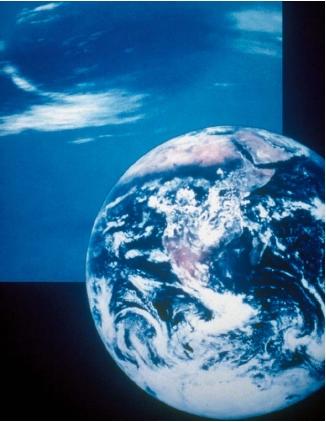Neptune
Neptune, the eighth planet away from the Sun, was discovered in 1846 by German astronomer Johann Galle, who based his finding on the mathematical predictions of French astronomer Urbain Le Verrier and English astronomer John Couch Adams. Because Neptune is so far way from the Sun—about 2.8 billion miles (4.5 billion kilometers)—it is difficult to observe. Very little was known about it until fairly recently. In August 1989, the U.S. space probe Voyager 2 flew by Neptune, finally providing some answers about this mysterious, beautiful globe.
Neptune is a large planet, with a mass 17 times that of Earth. The diameter at its equator is roughly 30,700 miles (49,400 kilometers). Neptune spins slightly faster than Earth—its day is equal to just over 19 Earth hours. It completes one revolution around the Sun in about 165 Earth years.
Since it is the color of water, Neptune was named for the Roman god of the sea. Its blue-green color, however, is due to methane gas. The thick outer atmospheric layer of hydrogen, helium, and methane is extremely cold: −350°F (−212°C). Below the atmosphere lies an ocean of ionized (electrically charged) water, ammonia, and methane ice. Underneath the ocean, which reaches thousands of miles in depth, is a rocky iron core.

Neptune is subject to the fiercest winds in the solar system. It has a layer of blue surface clouds that whip around with the wind and an upper layer of wispy white clouds of methane crystals that rotate with the planet. At the time of Voyager 2 's encounter, three storm systems were evident on its surface. The most prominent was a dark blue area called the Great Dark Spot, which was about the size of Earth. Another storm, about the size of our moon, was called the Small Dark Spot. Then there was Scooter, a small, fast-moving white storm system that seemed to chase the other storms around the planet. Its true nature remains a mystery.
In 1994, however, observations from the Hubble Space Telescope showed that the Great Dark Spot had disappeared. Astronomers theorize the spot either simply dissipated or is being masked by other aspects of the atmosphere. A few months later, the Hubble Space Telescope discovered a new dark spot in Neptune's northern hemisphere. This discovery has led astronomers to conclude that the planet's atmosphere changes rapidly, which might be due to slight changes in the temperature differences between the tops and bottoms of the clouds.
Neptune's magnetic field
A magnetic field has been measured on Neptune, tilted from its axis at a 48-degree angle and just missing the center of the planet by thousands of miles. This field is created by water beneath the surface that measures 4,000°F (2,204°C), water so hot and under so much pressure that it generates an electrical field.
Voyager 2 found that Neptune is encircled by at least four very faint rings, much less pronounced than the rings of Saturn, Jupiter, or Uranus. Although astronomers are not quite sure, they believe these rings are composed of particles, some of which measure over a mile across and are considered moonlets. These particles clump together in places, creating relatively bright arcs. This originally led astronomers to believe that only arcs—and not complete rings—were all that surrounded the planet.
The moons of Neptune
Neptune has eight moons, six of which were discovered by Voyager 2. The largest, Triton, was named for the son of the mythical Neptune. Triton was discovered a month after Neptune itself. It is 1,681 miles (3,705 kilometers) in diameter and has a surface temperature of −400°F (−240°C), making it the coldest place in the solar system. It has a number of unusual qualities. First, this peach-colored moon orbits Neptune in the opposite direction of all the other planets' satellites, and it rotates on its axis in the opposite direction that Neptune rotates. In addition, Voyager found that Triton has an atmosphere with layers of haze, clouds, and wind streaks. All of this information has led astronomers to conclude that Triton was captured by Neptune long ago from an independent orbit around the Sun.
The second Neptunian moon, a faint, small body called Nereid, was discovered in 1949 by Dutch astronomer Gerald Kuiper. The other six moons range from 30 miles (50 kilometers) to 250 miles (400 kilometers) in diameter.
[ See also Solar system ; Space probe ]